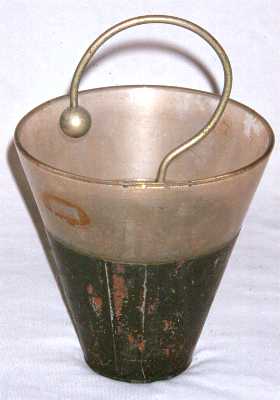
|
The "Leiden Jar With Removable Coats" was invented by
Benjamin Franklin in 1747-48. After the assembled jar is charged, the inner
conductor is lifted out by its glass handle and set on an insulating stand.
The glass dielectric cup is removed, and placed on another insulating stand,
leaving the outer conductor sitting alone on its own insulator. The observation
is made that the amount of charge on either conductor is very small, while
small bits of paper are attracted to the glass, showing that it is electrified.
When the condenser is reassembled, it is found to be fully charged.
The unmarked jar at the left is from the Greenslade
Collection and dates from the early part of the twentieth century.
The Leiden
Jars with fixed coats can be found elsewhere in this chapter.
REF: Thomas B. Greenslade, Jr., "Nineteenth Century
Textbook Illustrations XXVI....The Dissectible Condenser" Phys.
Teach., 16, 557-558 (1978)
|